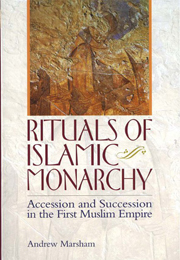Book contents
- Frontmatter
- Contents
- List of maps and figures
- Acknowledgements
- Map 1
- Map 2
- Map 3
- INTRODUCTION
- PART I LATE ANTIQUE ARABIA AND EARLY ISLAM (c. 550–c. 660)
- PART II THE UMAYYAD CALIPHATE (c. 660–750)
- PART III THE EARLY ABBASID CALIPHATE (c. 750–809)
- PART IV THE MIDDLE ABBASID CALIPHATE (809–865)
- INTRODUCTION
- 13 FROM THE CIVIL WAR TO SAMARRA (809–847)
- 14 CALIPHATE OF AL-MUTAWAKKIL (847–861)
- 15 THE OUTBREAK OF THE SECOND NINTH-CENTURY CIVIL WAR (861–865)
- 16 ABBASID DOCUMENTS FOR CALIPHAL ACCESSION
- CONCLUSION
- Genealogical table of Quraysh
- Genealogical table of the Abbasid caliphs
- Bibliography
- Index
13 - FROM THE CIVIL WAR TO SAMARRA (809–847)
from PART IV - THE MIDDLE ABBASID CALIPHATE (809–865)
Published online by Cambridge University Press: 05 September 2013
- Frontmatter
- Contents
- List of maps and figures
- Acknowledgements
- Map 1
- Map 2
- Map 3
- INTRODUCTION
- PART I LATE ANTIQUE ARABIA AND EARLY ISLAM (c. 550–c. 660)
- PART II THE UMAYYAD CALIPHATE (c. 660–750)
- PART III THE EARLY ABBASID CALIPHATE (c. 750–809)
- PART IV THE MIDDLE ABBASID CALIPHATE (809–865)
- INTRODUCTION
- 13 FROM THE CIVIL WAR TO SAMARRA (809–847)
- 14 CALIPHATE OF AL-MUTAWAKKIL (847–861)
- 15 THE OUTBREAK OF THE SECOND NINTH-CENTURY CIVIL WAR (861–865)
- 16 ABBASID DOCUMENTS FOR CALIPHAL ACCESSION
- CONCLUSION
- Genealogical table of Quraysh
- Genealogical table of the Abbasid caliphs
- Bibliography
- Index
Summary
Hārūn al-Rashīd died at the Khurasani city of Ṭūs on 24 March 809. His first heir, al-Amīn, was his deputy in Baghdad, 1,000 kilometres to the west; al-Maɔmūn, the second successor, was at Marw, 300 kilometres to the east. Accounts of Hārūn's death tend to focus on the importance of intelligence and communications in obtaining and maintaining power. The ṣāḥib al-barīd (‘chief of the post’) in Khurasan sent news to his counterpart in Baghdad, who informed the heir apparent, al-Amīn. A few days later, on 4 April 809, a second barīd messenger arrived in Baghdad, sent by Ṣāliḥ, the most senior of Hārūn's sons present at Ṭūs. Ṣāliḥ had presided over the burial of Hārūn (the right of the most senior relative present), before dispatching the formal announcement of the death and the caliphal seal, sceptre and mantle, by now well established as the insignia of the caliphate. Another message was sent north-east, to the second walī al- cahd, al-Maɔmūn, at Marw. Pledges of allegiance were immediately taken by both brothers from the notables and soldiers at Baghdad and Marw.
At Baghdad, al-Amīn is said to have moved from the palace of al-Khuld, which was on the east bank of the Tigris, opposite the Round City, to the original palace of al-Manṣūr within its walls. The following day – a Friday – the death was announced publicly and ‘the people’ (al-nās) were commanded to be present at the mosque.
- Type
- Chapter
- Information
- Rituals of Islamic MonarchyAccession and Succession in the First Muslim Empire, pp. 259 - 273Publisher: Edinburgh University PressPrint publication year: 2009



